+ Open data
Open data
- Basic information
Basic information
| Entry | Database: PDB / ID: 8j6m | ||||||
|---|---|---|---|---|---|---|---|
| Title | SIDT1 protein | ||||||
 Components Components | Green fluorescent protein,SID1 transmembrane family member 1 | ||||||
 Keywords Keywords |  TRANSCRIPTION / transport T1 TRANSCRIPTION / transport T1 | ||||||
| Function / homology |  Function and homology information Function and homology informationRNA transmembrane transporter activity / RNA transport /  cholesterol binding / cholesterol binding /  bioluminescence / generation of precursor metabolites and energy / bioluminescence / generation of precursor metabolites and energy /  double-stranded RNA binding / double-stranded RNA binding /  lysosome / lysosome /  plasma membrane plasma membraneSimilarity search - Function | ||||||
| Biological species |   Aequorea victoria (jellyfish) Aequorea victoria (jellyfish)  Homo sapiens (human) Homo sapiens (human) | ||||||
| Method |  ELECTRON MICROSCOPY / ELECTRON MICROSCOPY /  single particle reconstruction / single particle reconstruction /  cryo EM / Resolution: 2.77 Å cryo EM / Resolution: 2.77 Å | ||||||
 Authors Authors | Zhang, J.T. / Jiang, D.H. | ||||||
| Funding support |  China, 1items China, 1items
| ||||||
 Citation Citation |  Journal: Nat Struct Mol Biol / Year: 2024 Journal: Nat Struct Mol Biol / Year: 2024Title: Structural insights into double-stranded RNA recognition and transport by SID-1. Authors: Jiangtao Zhang / Chunhua Zhan / Junping Fan / Dian Wu / Ruixue Zhang / Di Wu / Xinyao Chen / Ying Lu / Ming Li / Min Lin / Jianke Gong / Daohua Jiang /  Abstract: RNA uptake by cells is critical for RNA-mediated gene interference (RNAi) and RNA-based therapeutics. In Caenorhabditis elegans, RNAi is systemic as a result of SID-1-mediated double-stranded RNA ...RNA uptake by cells is critical for RNA-mediated gene interference (RNAi) and RNA-based therapeutics. In Caenorhabditis elegans, RNAi is systemic as a result of SID-1-mediated double-stranded RNA (dsRNA) across cells. Despite the functional importance, the underlying mechanisms of dsRNA internalization by SID-1 remain elusive. Here we describe cryogenic electron microscopy structures of SID-1, SID-1-dsRNA complex and human SID-1 homologs SIDT1 and SIDT2, elucidating the structural basis of dsRNA recognition and import by SID-1. The homodimeric SID-1 homologs share conserved architecture, but only SID-1 possesses the molecular determinants within its extracellular domains for distinguishing dsRNA from single-stranded RNA and DNA. We show that the removal of the long intracellular loop between transmembrane helix 1 and 2 attenuates dsRNA uptake and systemic RNAi in vivo, suggesting a possible endocytic mechanism of SID-1-mediated dsRNA internalization. Our study provides mechanistic insights into dsRNA internalization by SID-1, which may facilitate the development of dsRNA applications based on SID-1. | ||||||
| History |
|
- Structure visualization
Structure visualization
| Structure viewer | Molecule:  Molmil Molmil Jmol/JSmol Jmol/JSmol |
|---|
- Downloads & links
Downloads & links
- Download
Download
| PDBx/mmCIF format |  8j6m.cif.gz 8j6m.cif.gz | 289.4 KB | Display |  PDBx/mmCIF format PDBx/mmCIF format |
|---|---|---|---|---|
| PDB format |  pdb8j6m.ent.gz pdb8j6m.ent.gz | 219 KB | Display |  PDB format PDB format |
| PDBx/mmJSON format |  8j6m.json.gz 8j6m.json.gz | Tree view |  PDBx/mmJSON format PDBx/mmJSON format | |
| Others |  Other downloads Other downloads |
-Validation report
| Arichive directory |  https://data.pdbj.org/pub/pdb/validation_reports/j6/8j6m https://data.pdbj.org/pub/pdb/validation_reports/j6/8j6m ftp://data.pdbj.org/pub/pdb/validation_reports/j6/8j6m ftp://data.pdbj.org/pub/pdb/validation_reports/j6/8j6m | HTTPS FTP |
|---|
-Related structure data
| Related structure data |  36008MC 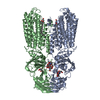 8hipC 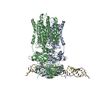 8hkeC 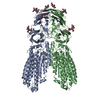 8j6oC M: map data used to model this data C: citing same article ( |
|---|---|
| Similar structure data | Similarity search - Function & homology  F&H Search F&H Search |
- Links
Links
- Assembly
Assembly
| Deposited unit | 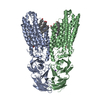
|
|---|---|
| 1 |
|
- Components
Components
-Protein , 1 types, 2 molecules BA
| #1: Protein | Mass: 124044.672 Da / Num. of mol.: 2 Source method: isolated from a genetically manipulated source Source: (gene. exp.)   Aequorea victoria (jellyfish), (gene. exp.) Aequorea victoria (jellyfish), (gene. exp.)   Homo sapiens (human) Homo sapiens (human)Gene: gfp, SIDT1 / Production host:   Homo sapiens (human) / References: UniProt: A0A059PIQ0, UniProt: Q9NXL6 Homo sapiens (human) / References: UniProt: A0A059PIQ0, UniProt: Q9NXL6 |
|---|
-Non-polymers , 5 types, 15 molecules 


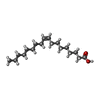





| #2: Chemical | ChemComp-CLR /  Cholesterol Cholesterol#3: Chemical | #4: Chemical | ChemComp-NA / | #5: Chemical |  Oleic acid Oleic acid#6: Water | ChemComp-HOH / |  Water Water |
|---|
-Details
| Has ligand of interest | Y |
|---|
-Experimental details
-Experiment
| Experiment | Method:  ELECTRON MICROSCOPY ELECTRON MICROSCOPY |
|---|---|
| EM experiment | Aggregation state: PARTICLE / 3D reconstruction method:  single particle reconstruction single particle reconstruction |
- Sample preparation
Sample preparation
| Component | Name: T1 / Type: COMPLEX / Entity ID: #1 / Source: RECOMBINANT |
|---|---|
| Source (natural) | Organism:   Homo sapiens (human) Homo sapiens (human) |
| Source (recombinant) | Organism:   Homo sapiens (human) Homo sapiens (human) |
| Buffer solution | pH: 7.5 |
| Specimen | Embedding applied: NO / Shadowing applied: NO / Staining applied : NO / Vitrification applied : NO / Vitrification applied : YES : YES |
Vitrification | Cryogen name: ETHANE |
- Electron microscopy imaging
Electron microscopy imaging
| Experimental equipment |  Model: Titan Krios / Image courtesy: FEI Company |
|---|---|
| Microscopy | Model: FEI TITAN KRIOS |
| Electron gun | Electron source : :  FIELD EMISSION GUN / Accelerating voltage: 300 kV / Illumination mode: FLOOD BEAM FIELD EMISSION GUN / Accelerating voltage: 300 kV / Illumination mode: FLOOD BEAM |
| Electron lens | Mode: BRIGHT FIELD Bright-field microscopy / Nominal defocus max: 2200 nm / Nominal defocus min: 1200 nm Bright-field microscopy / Nominal defocus max: 2200 nm / Nominal defocus min: 1200 nm |
| Image recording | Electron dose: 60 e/Å2 / Film or detector model: GATAN K2 SUMMIT (4k x 4k) |
- Processing
Processing
CTF correction | Type: PHASE FLIPPING AND AMPLITUDE CORRECTION |
|---|---|
3D reconstruction | Resolution: 2.77 Å / Resolution method: FSC 0.143 CUT-OFF / Num. of particles: 145765 / Symmetry type: POINT |
 Movie
Movie Controller
Controller






 PDBj
PDBj












